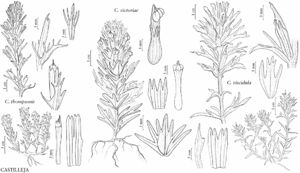Castilleja viscidula
Syn. Fl. N. Amer. 2(1): 297. 1878.
Herbs, perennial, 0.5–3 (–4) dm; from a woody caudex; with a taproot. Stems several, ascending to erect, decumbent at base, unbranched, sometimes branched, hairs spreading, long, soft, mixed with shorter stipitate-glandular ones. Leaves green to brown, linear, linear-lanceolate, lanceolate, or oblong (narrowly ovate nearing inflorescence), 1–4 (–5) cm, not fleshy, margins wavy, flat or involute, (0–) 2 (–5) -lobed, apex acute; lobes ascending-spreading, oblong to narrowly lanceolate, apex acute or obtuse. Inflorescences 2–14 × 1–3.5 cm; bracts proximally greenish to greenish brown, distally pale-yellow, cream, or yellow-green, sometimes yellow-orange or red (sometimes gradually differentiated from proximal coloration), lanceolate, broadly lanceolate, or oblong, 3 (–5) -lobed, proximal wavy-margined; lobes ascending, linear to narrowly lanceolate, long, arising near or above mid length, sometimes wavy-margined, apex acute to rounded. Calyces colored as bracts or proximally paler, (10–) 14–18 mm; abaxial and adaxial clefts (4–) 5–9 mm, 30–40% of calyx length, deeper than laterals, lateral (1–) 2–6 mm, ca. 25% of calyx length; lobes narrowly ovate to lanceolate, linear, or narrowly lanceolate, apex acute to obtuse. Corollas straight, 16–22 (–25) mm; tube 10–15 mm; beak exserted, straight to sometimes curved, adaxially green to yellow, 5–8 (–9) mm; abaxial lip green or yellow, sometimes deep purple, reduced, inconspicuous, often visible in abaxial cleft, 1–2 mm, 20% as long as beak; teeth erect, green to white, sometimes yellow or pink, 0.5–1 mm. 2n = 24, 72.
Phenology: Flowering Jun–Aug.
Habitat: Dry to mesic sagebrush steppes, rocky slopes, ledges, open woodlands, montane to subalpine.
Elevation: 2000–3200 m.
Distribution
Idaho, Nev., Oreg.
Discussion
Castilleja viscidula is a member of the complex including C. applegatei and C. martini, centered in California. Castilleja viscidula favors isolated mountain ranges, from the Wallowa and, possibly, the Blue mountains of northeastern Oregon, eastward into southwestern Idaho, and southward into central Nevada. Most populations are greenish yellow, but in one portion of the Wallowa Mountains, reddish bracted plants are common. Many yellowish bracted populations in the same mountain range surround this reddish population. Intermediate color forms are rarely encountered. Most ranges where C. viscidula occurs have generated slightly differing local races, demonstrating some reproductive isolation and divergence. In addition, hybrid swarms between this species and C. nana are known from several mountain ranges in central and northern Nevada, and an apparent hybrid with C. flava var. flava is known from the Independence Mountains of northern Nevada.
Selected References
None.
Lower Taxa
"dm" is not declared as a valid unit of measurement for this property.
